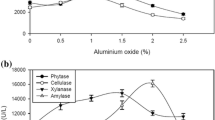Abstract
Schizophyllum commune is a wood-rotting filamentous fungus that secrets a homopolysaccharide called as schizophyllan. Schizophyllan has several applications such as enhanced oil recovery, pharmaceutical materials and an anti-cancer drug carrier. Biomass growth and schizophyllan production increase the viscosity of the cultivation medium, thus resulting in mass transfer limitation for the substrate. In this study, adding talc and aluminium oxide microparticles into the cultivation medium was studied to improve the fungal growth and morphology. The response surface methodology and one factor at a time were applied to find the effects of microparticles with different sizes and concentrations on the schizophyllan production. The optimum concentration and size of aluminium oxide microparticles were obtained as 20 g L−1 and < 30 µm, respectively. Aluminium oxide microparticles in shake flask culture caused to increase the schizophyllan production from 10 to 15 g L−1 and decrease the cultivation time from 10 to 7 days. The production yield also increased from 0.11 to 0.30 g of schizophyllan/g glucose. Bioreactor cultivation showed a twofold increase in schizophyllan production from 1.5 to 3 g L−1. The results of this study suggested a significant increase in the production of schizophyllan using a low-cost “microparticle-enhanced cultivation” without any further optimization of the culture medium.









Similar content being viewed by others
References
Gibbs P, Seviour R, Schmid F (2000) Growth of filamentous fungi in submerged culture: problems and possible solutions. Crit Rev Biotechnol 20:17–48
Mousaviasl S, Saleh T, Shojaosadati SA, Boddohi S (2018) Synthesis and characterization of schizophyllan nanogels via inverse emulsion using biobased materials. Int J Biol Macromol 120:468–474
Jamshidian H, Shojaosadati SA, Mousavi SM, Soudi MR, Vilaplana F (2017) Implications of recovery procedures on structural and rheological properties of schizophyllan produced from date syrup. Int J Biol Macromol 105:36–44
Hamedi S, Shojaosadati SA, Najafi V, Alizadeh V (2020) A novel double-network antibacterial hydrogel based on aminated bacterial cellulose and schizophyllan. Carbohyd Polym 229:115383
Rau U, Gura E, Olszewski E, Wagner F (1992) Enhanced glucan formation of filamentous fungi by effective mixing, oxygen limitation and fed-batch processing. J Ind Microbiol Biotechnol 9:19–25
Shu CH, Chou PF, Hsu I (2005) Effects of morphology and oxygen supply on schizophyllan formation by Schizophyllum commune using a pellet size controlling bioreactor. J Chem Technol Biotechnol 80:1383–1388
Kumari M, Survase SA, Singhal RS (2008) Production of schizophyllan using Schizophyllum commune NRCM. Biores Technol 99:1036–1043
Hao L-m, Xing X-h, Li Z, Zhang J-c, Sun J-x, Jia S-r, Qiao C-s, Wu T (2010) Optimization of effect factors for mycelial growth and exopolysaccharide production by Schizophyllum commune. Appl Biochem Biotechnol 160:621–631
Sutivisedsak N, Leathers TD, Nunnally MS, Price NP, Biresaw G (2013) Utilization of agricultural biomass in the production of the biopolymer schizophyllan. J Ind Microbiol Biotechnol 40:105–112
Jamshidian H, Shojaosadati SA, Vilaplana F, Mousavi SM, Soudi MR (2016) Characterization and optimization of schizophyllan production from date syrup. Int J Biol Macromol 92:484–493
Antecka A, Bizukojc M, Ledakowicz S (2016) Modern morphological engineering techniques for improving productivity of filamentous fungi in submerged cultures. World J Microbiol Biotechnol 32:193
Walisko R, Krull R, Schrader J, Wittmann C (2012) Microparticle based morphology engineering of filamentous microorganisms for industrial bio-production. Biotech Lett 34:1975–1982
Kaup BA, Ehrich K, Pescheck M, Schrader J (2008) Microparticle-enhanced cultivation of filamentous microorganisms: Increased chloroperoxidase formation by Caldariomyces fumago as an example. Biotechnol Bioeng 99:491–498
Driouch H, Hänsch R, Wucherpfennig T, Krull R, Wittmann C (2012) Improved enzyme production by bio-pellets of Aspergillus niger: targeted morphology engineering using titanate microparticles. Biotechnol Bioeng 109:462–471
Driouch H, Sommer B, Wittmann C (2010) Morphology engineering of Aspergillus niger for improved enzyme production. Biotechnol Bioeng 105:1058–1068
Coban HB, Demirci A, Turhan I (2015) Microparticle-enhanced Aspergillus ficuum phytase production and evaluation of fungal morphology in submerged fermentation. Bioprocess Biosyst Eng 38:1075–1080
Gonciarz J, Bizukojc M (2014) Adding talc microparticles to Aspergillus terreus ATCC 20542 preculture decreases fungal pellet size and improves lovastatin production. Eng Life Sci 14:190–200
Kowalska A, Boruta T, Bizukojć M (2018) Morphological evolution of various fungal species in the presence and absence of aluminum oxide microparticles: comparative and quantitative insights into microparticle-enhanced cultivation (MPEC). Microbiologyopen 7:e00603
Etschmann MMW, Huth I, Walisko R, Schuster J, Krull R, Holtmann D, Schrader J et al (2015) Improving 2-phenylethanol and 6-pentyl-α-pyrone production with fungi by microparticle-enhanced cultivation (MPEC). Yeast 32(1):145–157
Yatmaz E, Karahalil E, Germec M, Ilgin M, Turhan İ (2016) Controlling filamentous fungi morphology with microparticles to enhanced β-mannanase production. Bioprocess Biosyst Eng 39:1391–1399
Zhang Y, Kong H, Fang Y, Nishinari K, Phillips GO (2013) Schizophyllan: a review on its structure, properties, bioactivities and recent developments. Bioact Carbohydr Diet Fibre 1:53–71
Papagianni M (2004) Fungal morphology and metabolite production in submerged mycelial processes. Biotechnol Adv 22:189–259
Gonciarz J, Kowalska A, Bizukojc M (2016) Application of microparticle-enhanced cultivation to increase the access of oxygen to Aspergillus terreus ATCC 20542 mycelium and intensify lovastatin biosynthesis in batch and continuous fed-batch stirred tank bioreactors. Biochem Eng J 109:178–188
Coban HB, Demirci A (2016) Enhancement and modeling of micro particle-added Rhizopus oryzae lactic acid production. Bioprocess Biosyst Eng 39(2):323–330
Acknowledgements
The authors are grateful to thank Dr. Alireza Chackoshian Khorasani and Mahdi Soleimani SalehAbadi for their technical supports and assistance during this work.
Author information
Authors and Affiliations
Corresponding author
Ethics declarations
Conflict of interest
The authors declare no competing financial interests.
Additional information
Publisher's Note
Springer Nature remains neutral with regard to jurisdictional claims in published maps and institutional affiliations.
Rights and permissions
About this article
Cite this article
Alizadeh, V., Shojaosadati, S.A. & Zamir, S.M. Enhancement of schizophyllan production in Schizophyllum commune using microparticles in medium. Bioprocess Biosyst Eng 44, 317–328 (2021). https://doi.org/10.1007/s00449-020-02444-z
Received:
Accepted:
Published:
Issue Date:
DOI: https://doi.org/10.1007/s00449-020-02444-z




